Update #7: Beaufort Island
Over a very long (17+ hour) day, we just completed one of the most unusual, pleasant, and exciting field excursions I’ve ever had in the Antarctic. After rising at 5 AM, we were picked up at the lab for a ride to the ice pier to board the icebreaker Oden. Oden is a Swedish ship, operated by the Swedish Maritime Administration that has been contracted by the NSF for the past few years to clear the ice channel for arrival and departure of the resupply ships that McMurdo depends upon. A secondary component of the contract is for Oden to provide support for selected science efforts, which is why we were going onboard. David Ainley’s group of penguin biologists needed to go to Beaufort Island to band chicks for the season, we needed to collect sediments from some profiles that Ainley had found previously, and two artists-in-residence were going along for their project as well. The NSF science rep arranged the trip, and she was along for the ride too. The ship slowly motored to the pier and dropped the gangway, and we boarded with our field gear.
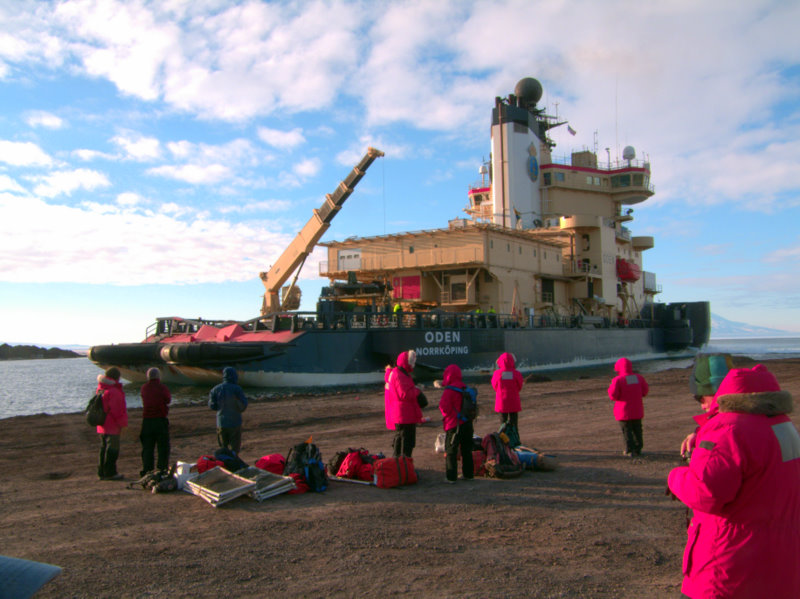
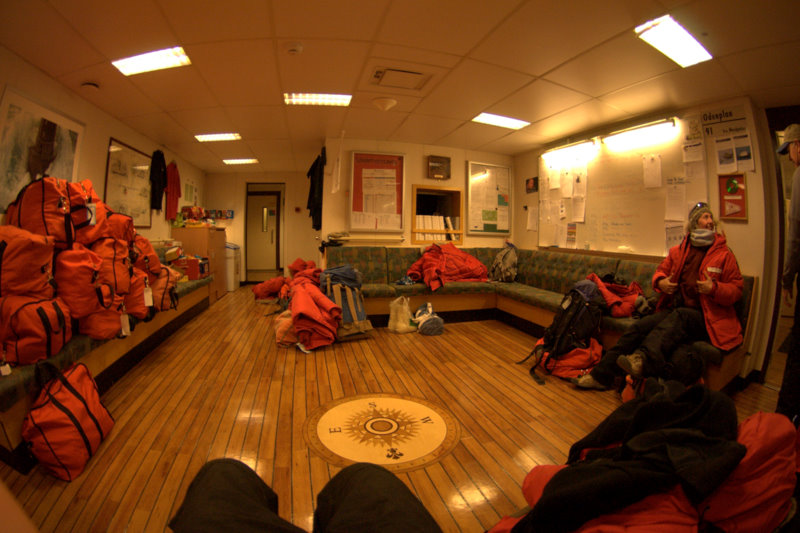
The Oden arrives at the ice pier (left), and the impressive stateroom on the first deck (right).
I was aboard the Coast Guard icebreaker Polar Star in 2001, when “morale cruises” were being offered for McMurdo residents up the ice channel to the ice edge, and that ship was quite impressive. But Oden offers a bit of European elegance to the art of breaking ice, and I was even more impressed with the facilities I found onboard her. Beautiful, hardwood floors cover every deck, a steep staircase with hardwood banisters forms the core of the interior, and the rest of the inside of the ship feels more like a luxury hotel than a trade vessel. The first mate walked us through the emergency procedures, showing us where the exposure suits could be found and how to fit them, where to muster to board lifeboats, and then we were turned loose with the run of the ship for the 5-hour journey to Beaufort Island. We all went onto the deck for the short stretch of the ship channel, as whales frequently hang out here, and we saw numerous orca patrolling the icy edge of the channel, as well as lots of seals, Adélies, and even a lone emperor penguin. The crew took the opportunity to break a bit more ice as we cruised, and I was struck by the beautiful but violent nature of the clash between steel and sea ice. At 7:30 we were served an elegant breakfast in the galley (much more Mario Zuccelli Station than McMurdo food with a Swedish chef), and we climbed the seemingly endless flights of stairs up to the bridge.
Here are few short video clips of Oden bashing aside the brash ice in the ship channel.

Oden's elegent central staircase (left) and the first mate demonstrates exposure suits (right)

One of Oden's 43-person lifeboats (left), and the elegant crew lounge (right).
The bridge is an impressive place, far above the sea surface, with huge windows, a spacious interior and high-tech instrumentation. The ship must pretty much pilot itself in open water, as the crew only occasionally pushed buttons or checked display screens. Doorways access catwalks and the top deck, and most of us soon ended up outside again, watching for whales or just enjoying the fantastic scenery sliding by: glinting tabular icebergs, older, degraded bergs in a variety of fantastic shapes and colors, occasional groups of Adélies porpoising by, and spectacular views of Ross Island’s capes, glaciers, and peaks. We were soon passing Cape Bird, and we could clearly see all the landmarks from our work there, including the wonderful hut on the terrace. David called Kerry on his specially-modified handheld (McMurdo radios cannot talk to Kiwi radios because of some extra-secure measures Mac Ops uses), and sent her our greetings while we motored past. She was set to be pulled out today, but it has obviously just snowed, and the cloud ceiling was low so her pick-up might be delayed.

The impressive bridge on Oden (left) and the Google Earth-like navigation screen (right).

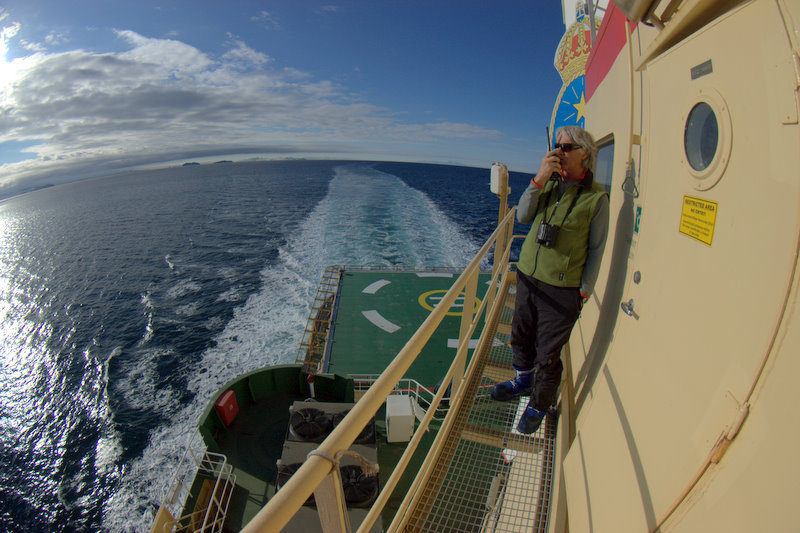
Iceberg from the top deck of the Oden (left), and David Ainley calls Kerry at Cape Bird as we sail past (right).
As we neared Beaufort Island, preparations began for our landing. The Oden has a small skiff that they use for landings, and the deck crane lifted it from its perch and placed it in the water. We departed in two groups- Ainley’s banding party in the first trip to shore, and our group with the artists in the second. The small boat looked tiny in the vast bay on the west side of Beaufort as the first team motored in, but it didn’t take them long to return to the Oden for us. We lowered packs to the skiff, and climbed down the ladder to board, which was no small trick considering the bucking movements of the small boat as waves rolled under the icebreaker. The trip in was quick, with only a bit of oversplash, and soon we leapt over the breaking surf and onto the beach at Beaufort.
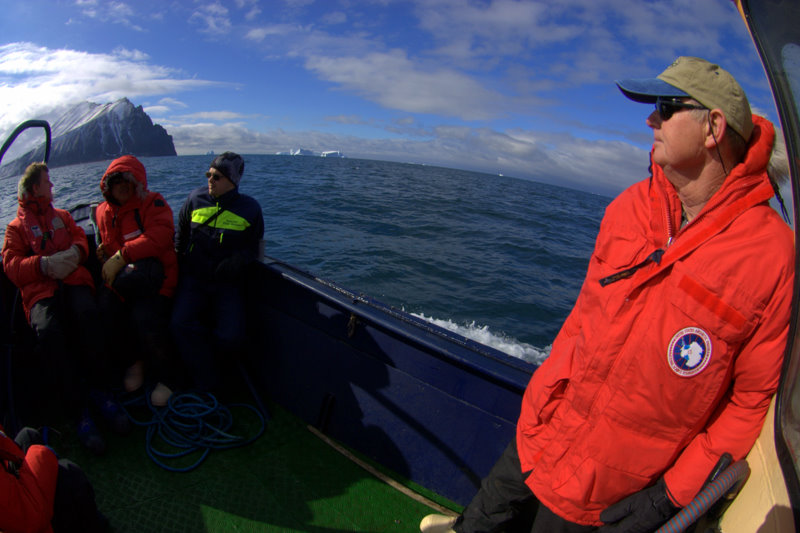
The Oden's skiff motors Ainley's group to shore (left) and Steve in the skiff during our ride in (right).
The beach was amazing and perhaps the most pristine ASPA (Antarctic Specially Protected Area) I’ve ever visited. Weddell seals were hauled out in great numbers, and seemed utterly unconcerned about our arrival. Thousands of chicks and harried parents milled about in the huge colony (20,000 breeding pairs), skuas wheeled overhead, and a giant iceberg loomed in the southern horizon. The surface of the occupied sites was stained bright red from the krill-colored guano, and the healthy state of the chicks indicated that a rich food source was nearby. We hefted our packs and headed down the beach for the exposure that Ainley had observed. Only a few hundred meters down the beach a wave-cut terrace appeared, only a couple of meters high but exposing several ornithogenic levels. We located the most clean-cut of the profiles, and started probing for remains. Right away we realized how rich the deposit was- bone, feather, and eggshell was either visible at the surface or was revealed with only a bit of probing. We could clearly see a hiatus indicated by sterile sediments just over 12 cm from the active surface deposit, then a single prolonged occupation (or perhaps two with a short break) represented by a thick layer of ornithogenic soil and pebbles. With some focused searching, we found some ideal sub-fossil remains precisely on the bottoms of the various past occupations. These in situ bone samples will be perfect for defining the chronology of occupation. Steve sampled and screened some sediments for otoliths and other microscopic food remains while I collected bones, eggshell fragments, and feathers from the various strata.

The beach at Beaufort Island with iceberg offshore (left), and the Beaufort Island colony on southernmost beach (right).
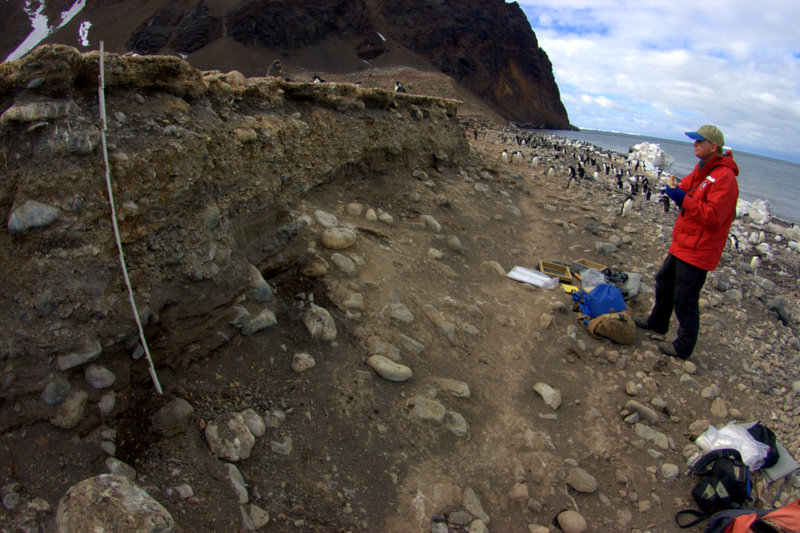
Sediments exposed in profile on Beaufort Island's beach (left) and bone right in the bottom of the ornithogenic layer (right).
Steve exposes bone in the top of the lowest ornithogenic layer.
Work goes quickly on these profiled deposits, so we finished up with our sampling in short order. We then traversed through a portion of the colony searching for eggshell fragments for isotope analysis, and saw Lui sampling sediments from one of the organic-rich ponds that captures run-off from the penguin mounds. We checked out a historic monument I’d read about- a sign erected by the New Zealand Endeavour expedition in 1959-1960. Far too soon we saw the little boat returning from shuttling Ainley’s crew back to Oden, and we knew it was time to go. The captain had already nixed our request to go to the north end of the island to re-visit the site with the oldest penguin remains in the Ross Sea, so unfortunately that will have to wait for a future field season. As we waited for the boat to pull in, I watched the Weddell seals lazily reposition themselves for comfort, and a curious Adélie approached to see what I was doing. The boat arrived at a natural pier on the edge of a grounded iceberg, and soon we were on our way back to the icebreaker. Climbing back up the ladder was a final challenge, but although everyone struggled a bit catching the bottom rung from the bobbing skiff, we all made it aboard safely.
Lui samples organic-rich sediments in a pond on Beaufort Island (left), and the Endeavour historic monument (right).
Wildlife on the beach at Beaufort Island: a lazy Weddell seal (left) and curious Adélie penguin (right).
Steve climbs the ladder to reboard the Oden from the small skiff.
Cruising back home was as delightful as the trip out- we had a beer in the bar to celebrate, then another delicious meal in the galley. Afterwards we all migrated to our favorite spots to watch the passing scenery. The light had improved greatly at Cape Bird, and we got a unique perspective on the layout of the sub-colonies along the extended coastline (later we heard that Rob the helo pilot did make it in and successfully retrieved Kerry and Isaac). The icebergs along our route had moved significantly since our trip up, and we passed closely to some very scenic ones that had been in the far distance earlier. We cruised along the ice edge and saw a few minke whales, but they keep a low profile in the water and are difficult to photograph unless you are lucky on the timing (but see Steve and Eva's updates for photos of whales that I missed). When we entered the ship channel the Oden was back to ice breaking, as the brash had been blown into a solid utmass in several places, and the leads between had begun to freeze again. Watching from above it was possible to see several stages of sea ice formation- frazil ice on the surface forming layers of “grease ice”, and patches of pancake ice beginning to shape up between the broken floes. It was also possible to see how icebreakers use the strength of their hulls to force open small leads between floes, and to open up channels by pushing the ice away. Again the violence of the interaction between steel and ice amazed me as the ship didn’t slow a bit as it bulled through the pack. What Shackleton wouldn’t have given for such capability a hundred years ago. We soon arrived back at the ice pier, and waited for the slow docking procedure to complete. Eventually we dragged our sediment bags and packs down the gangplank and into the waiting van. After a bit of McMurdo-related annoyance at being ditched there for half an hour, we finally arrived back at Crary to drop off things at the lab.
Oden's lovely bar- toasting the success of a short-but-sweet field day.
View of Cape Bird from Oden- the north colony dwarfed by the Bird Ice Cap, and the hut just visible as a tiny rectangle on the right.
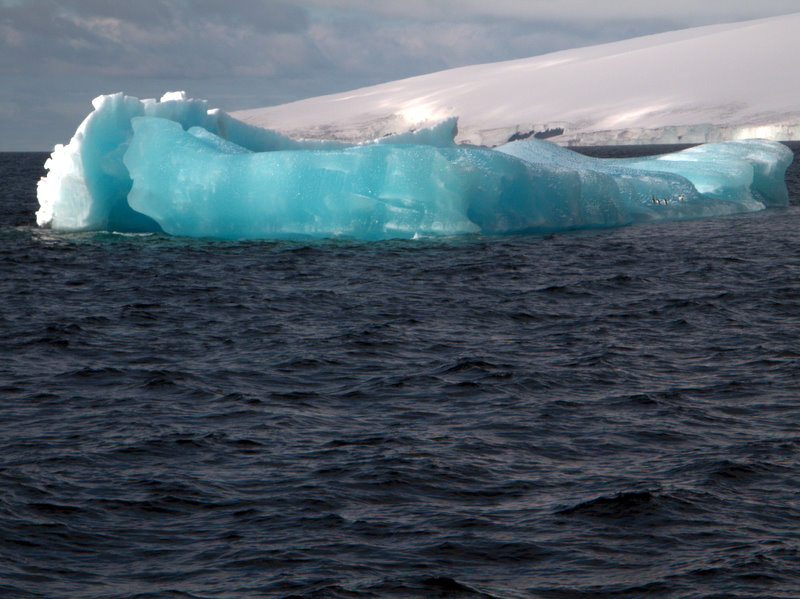
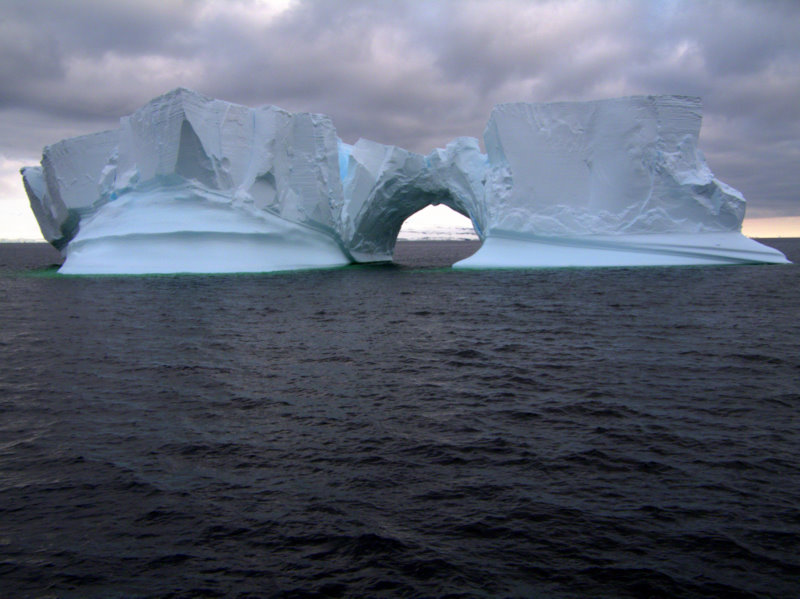
Blue berg with penguin hitchhikers on shelf at far right (left) and amazing arch-iceberg (right).

View of Oden breaking pack ice in the ship channel (left) and Jurek on the deck sightseeing during the trip back to McMurdo (right).
With this trip to Beaufort Island complete (as least as far as sampling the site in the south colony we had not visited before), our field season has now been a tremendous success. We still are hoping to get to Cape Crozier on a day trip or two to sample deposits in the east colony that we have not visited before, and we have helos scheduled for several days starting Monday. But Crozier is difficult to reach because of frequent poor weather, so it's possible we won't get there, or potentially could get stranded there and have to live out of survival bags for a few days while waiting for flyable weather (only one veteran in our FSTP refresher course could claim that- maybe next time we can too!). Tomorrow is Sunday, which means waffles at brunch and a day to relax before readying for the field once again. I'll write another update next week regardless, and a summary of our field season.
Cheers! Larry